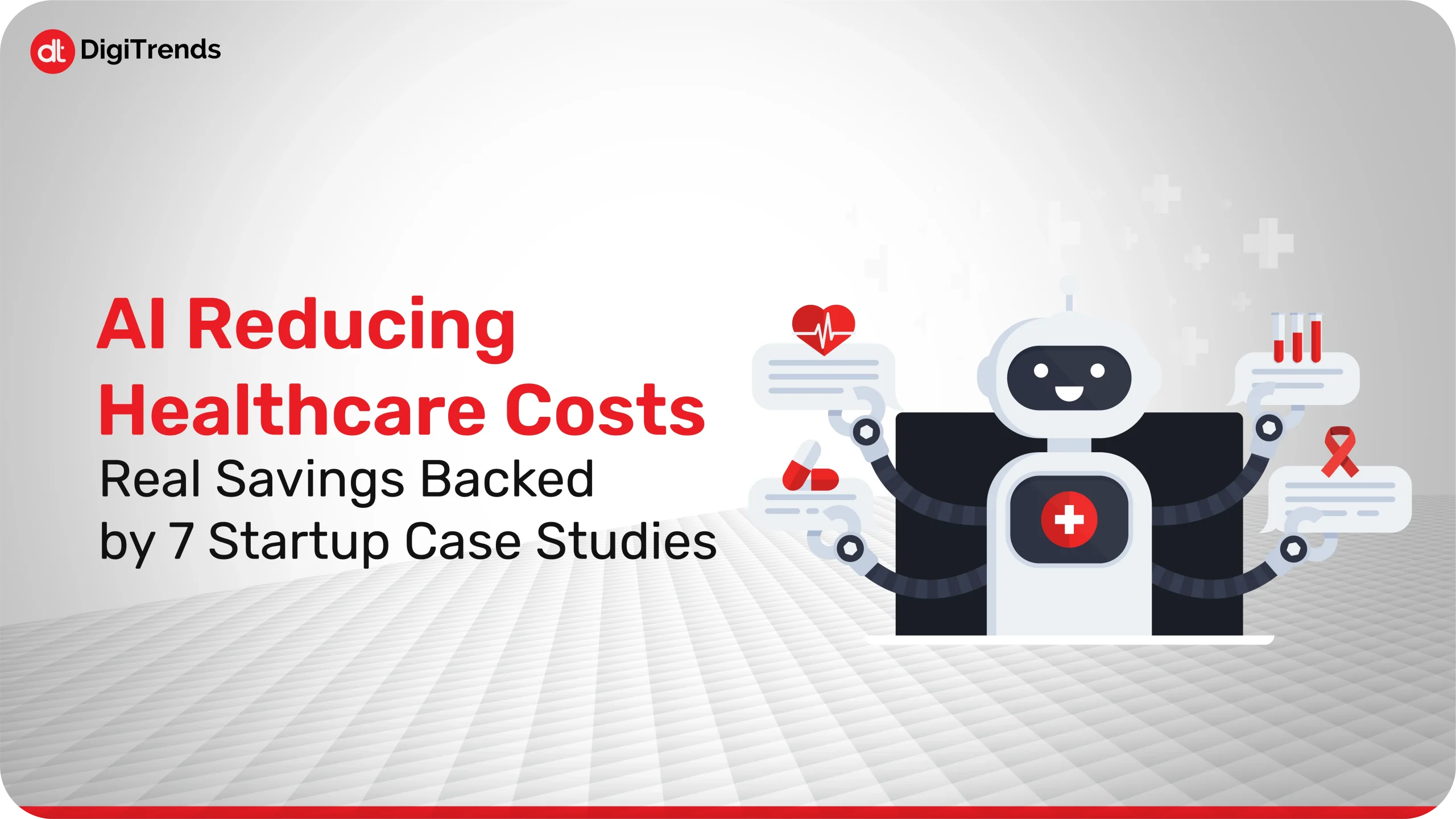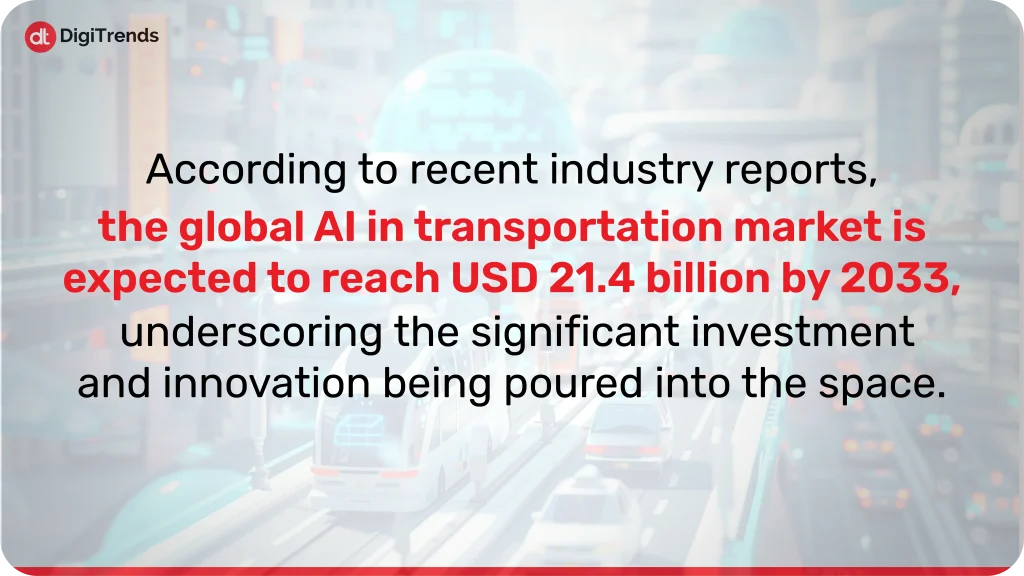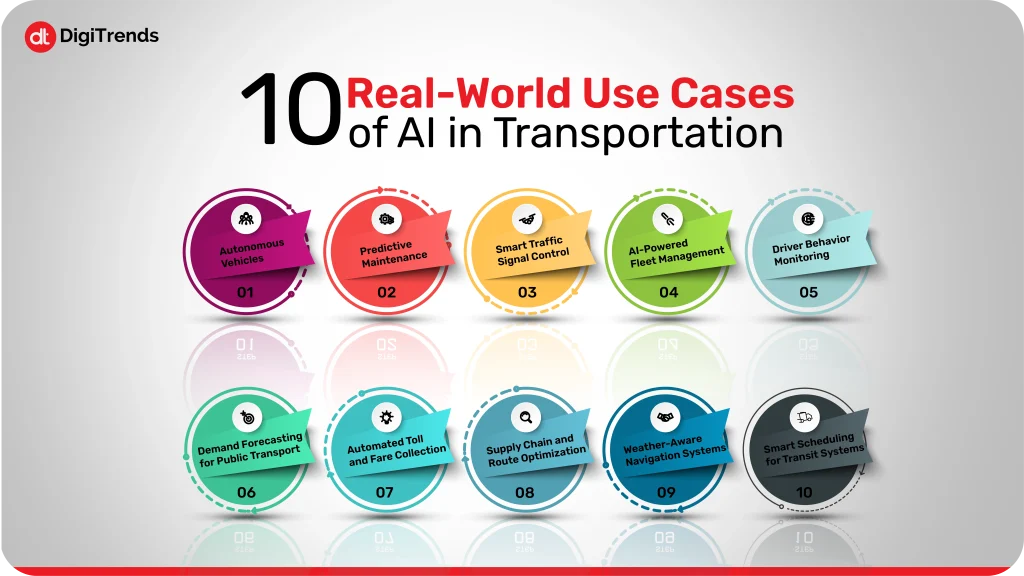
AI Reducing Healthcare Costs: Real Savings Backed by 7 Startup Case Studies
Look at the real numbers from healthcare organizations that show AI reducing healthcare costs in real. The AI lens makes costs look controllable.
Continue Reading
We are all aware of the potential of AI in the fastly moving world. According to research, the global artificial intelligence market is projected to be valued at USD 21.4 billion by 2033.
As artificial intelligence brings transformation to various industries, the transportation industry is also undergoing a massive transformation, and AI is in the driver’s seat.
AI can now handle the delivery of goods across the globe. From predictive maintenance and autonomous fleets to real-time traffic optimization and smarter logistics.
In the case of modern businesses, it is not merely an exciting change; it is a necessary one. Using AI in transportation will result in minimized expenses, accelerated speed, increased safety, and customer satisfaction. Artificial intelligence holds great potential as it can make a difference in the supply chain, in ride-hailing services, in the mobility of people, and in urban mobility.
In this blog, we’ll break down the top 10 enterprise use cases where AI is making waves in transportation and show you exactly how it’s turning challenges into opportunities.

Similar to every industry that is now benefiting from AI, the global AI in transportation market is also shifting gears fast. There is a rise in smart mobility solutions and digital logistics, and artificial intelligence is becoming the engine behind a more efficient, automated, and data-driven transportation landscape.
Some of the AI technologies that are redefining the mobility of people and goods are autonomous cars and predictive maintenance, real-time traffic analysis, and intelligent fleet management.
According to research, the global AI in Transportation Market size is expected to be worth around USD 21.4 Billion by 2033. The growth of AI in transportation is due to several factors, including rising demand for faster deliveries, the push for cost reduction, pressure to lower carbon emissions, and the increasing adoption of connected and electric vehicles.
The economy of the world is now driven by technology, and it is very competitive, due to which enterprises are turning to AI, and they are not doing it just to improve performance, but to stay competitive too.
As governments and businesses continue with their great investment in infrastructure, artificial intelligence research, and startups in the mobility sector, the future of transportation is set to jump a huge notch. In the contemporary business environment, the key to keeping pace with the current market is to adopt AI as soon as possible before the concern becomes steeper.
Now that you are aware of the growth of artificial intelligence in the transportation market, let’s explore the benefits of AI and transportation together.
Like many other industries, the transportation industry is also changing fast with the use of artificial intelligence, as people now have access to smarter, safer, and more sustainable vehicles.
The combination of AI and transportation is helping us reach a new place of growth where everyday commuting and manufacturing are efficient and intelligent all over the world.
Here are seven key benefits enterprises are gaining from implementing AI in transportation management:
While looking at the benefits of artificial intelligence in transportation, let’s start with safety, because everybody wants safe rides, right?
AI is helping to make driving safer for people through the analysis of data in real-time and the identification of risks that may arise. It warns the driver about these risks before the problem occurs, which prepares the driver for the problems beforehand. There are also options like keeping drivers in lane and collision warnings that provide the driver with necessary warnings when they are most needed. It is like having an extra pair of eyes for you that are on the road so that accidents are prevented before it’s too late.
We all know that in emergencies, every second counts, and AI can help with it too.
The smart systems nowadays can easily detect accidents instantly and alert emergency services to the exact location. That means help can come faster, injuries can be avoided or not be so risky, and people who come to help in such cases can arrive knowing exactly what they’re going to deal with. Think about it, isn’t it great for transportation and travel management? It’s basically technology that genuinely makes a difference and helps where and whenever the help is needed.
One of the things about travel that is most frustrating is traffic jams.
And it can be thankfully solved through artificial intelligence.
It helps with keeping an eye on traffic flow and adjusting signal timings on the fly, which helps keep things moving. Plus, it can suggest quicker routes, saving the drivers’ time and minimizing their frustration too. Now, whether you’re cruising through the city or on the highway, AI will help smooth out the bumps for you.
AI can also benefit the transportation industry by helping vehicles run more efficiently. It can optimize how and where we drive, and it cuts down on unnecessary fuel use and emissions. And when paired with electric or hybrid vehicles, it is very sustainable. So, the use of artificial intelligence in transportation is better for the planet and your fuel bill? That’s a win-win, right?
You must be thinking how AI is helping with improved connectivity in transportation?
Well! AI enables your car to “talk” to the world around it. That is called Vehicle-to-Everything (V2X). It basically shares data with traffic signals, road signs, and even other vehicles to give you real-time updates and alerts. This helps drivers in being more informed so they can make smarter decisions on the road without any delays.
Sustainability for transportation is not just a term now, because it is now a real deal and in action, as AI is leading its way.
The uses of AI will decrease fuel costs, emissions, and the consumption of wasted energy as it advises taking smarter routes and driving more efficiently. There is a rising demand for EVs, which is enabling the transformation of mobility into something far more environmentally friendly.
Lastly, AI also brings a bit of personal effect to your drives as it can easily learn your habits, like your go-to routes, favorite playlists, and even how warm you like the car, and creates the experience just for you.
The more you drive, the smarter it gets. So yeah, it’s like having a co-pilot who actually knows what you like.
These benefits highlight how AI is not just enhancing transportation; it’s redefining it. By embracing AI-driven solutions, modern enterprises can unlock safer, greener, and more efficient mobility systems that are built for the future.

From highways to shipping docks, AI is transforming how transportation systems operate, streamlining processes, improving safety, and driving innovation at every level.
Here are 10 impactful use cases of AI in the transportation sector:
AI is at the heart of self-driving technology. Using a mix of computer vision, sensor fusion, and deep learning, autonomous vehicles can recognize traffic signs, detect pedestrians, avoid obstacles, and make real-time driving decisions. These capabilities are being applied in everything from passenger cars and delivery bots to long-haul trucks, reducing human error and improving transportation safety.
Instead of reacting to breakdowns, AI allows transportation companies to be proactive. By analyzing sensor data from engines, brakes, and other components, AI can predict when a part is likely to fail. This helps schedule timely maintenance, reduce unexpected downtimes, and cut operational costs, especially valuable for airlines, shipping lines, and large fleet operators.
AI enables real-time traffic signal optimization by analyzing vehicle flow, pedestrian movement, and congestion patterns. Unlike traditional timed signals, AI-powered systems can adapt to current conditions, reducing bottlenecks, improving traffic flow, and lowering vehicle idle time. Cities adopting this technology are seeing measurable reductions in emissions and travel delays.
Managing commercial fleets has become significantly smarter with AI. These systems track vehicle performance, monitor routes, analyze driver behavior, and optimize fuel efficiency. Whether it’s last-mile delivery vans or global freight carriers, AI improves logistics planning, reduces delays, and enhances resource utilization across the board.
AI-equipped cameras and sensors inside vehicles can detect signs of driver fatigue, distraction, or drowsiness. By tracking facial expressions, head position, and eye movement, the system can issue warnings or initiate safety protocols. This use case is especially critical in commercial transport and long-haul trucking, where safety is very important.
Transit authorities use AI to analyze ridership patterns, ticketing data, and traffic flow to better predict demand. This helps optimize bus and train schedules, adjust capacity in real time, and improve overall public transport efficiency. During large events or rush hours, AI ensures that services are aligned with real-world needs.
AI enhances toll collection systems through technologies like automatic license plate recognition (ALPR) and RFID-based fare systems. These allow vehicles to pass through checkpoints without stopping, reducing congestion and operational costs. The result is faster travel times and seamless customer experiences on highways and transit systems.
AI systems evaluate variables such as fuel prices, traffic, weather conditions, and delivery deadlines to recommend the most efficient shipping routes. For supply chain managers, this means better planning, faster deliveries, and reduced fuel consumption, all contributing to improved customer satisfaction and cost savings.
By integrating weather forecasting data with navigation systems, AI can offer route suggestions that avoid storms, snow, fog, or floods. These smart adjustments help drivers steer clear of delays and danger, especially in logistics and emergency transport, where timing is critical.
AI models help mass transit operators build dynamic schedules that account for traffic conditions, vehicle availability, and rider behavior. This results in shorter wait times, better vehicle utilization, and smoother service during disruptions, creating a more reliable experience for commuters and city planners alike.
These real-world use cases show how AI is not just enhancing transportation; it’s transforming it from the ground up. From safety and efficiency to sustainability and personalization, the possibilities are only expanding.
While AI brings tremendous potential to the transportation industry, its implementation isn’t without obstacles.
Here are some key challenges that enterprises and governments often face:
Deploying AI solutions, whether for autonomous vehicles, predictive systems, or smart infrastructure, requires significant upfront capital. From hardware and software to integration and training, the costs can be a barrier for many organizations, especially small to mid-sized operators.
AI systems rely heavily on clean, accurate, and large volumes of data to function effectively. Inconsistent data collection methods, fragmented sources, or lack of real-time data can limit AI’s accuracy and decision-making capabilities, especially in complex or fast-changing environments.
AI in transportation often involves public safety and critical infrastructure, which means it’s subject to strict regulations. Legal uncertainty around liability in autonomous systems or data usage can slow down implementation, especially in jurisdictions where laws are still evolving.
Many transportation networks still rely on outdated infrastructure or legacy software. Integrating AI into these systems can be technically challenging, requiring time, custom development, and a change in operational culture.
As AI continues to reshape the transportation industry, the road ahead is full of opportunities and a few challenges. By understanding both the benefits and the barriers, enterprises can make informed decisions that drive smarter, safer, and more sustainable mobility solutions.
At DigiTrends, we’re committed to helping organizations unlock the full potential of AI in transportation through innovative, future-ready solutions tailored to modern business needs. The journey has just begun, and we’re here to help you lead the way.
The future of AI in transportation is not just about automation; it’s about intelligent ecosystems that adapt, learn, and evolve in real time. One major trend on the horizon is hyper-personalization, where vehicles and transit systems tailor every experience to the user. From predictive route planning based on individual habits to in-car assistants that learn your preferences, AI will make mobility not just efficient, but intuitive and user-focused.
Another exciting shift is the rise of connected and autonomous ecosystems. We’re moving toward a world where vehicles communicate seamlessly with each other (V2V), with infrastructure (V2I), and with the cloud (V2X). These networks will help reduce traffic congestion, enable faster emergency response, and improve road safety at scale. Coupled with edge computing and 5G, real-time decision-making will reach new heights.
Sustainability will also play a bigger role in shaping AI-driven transport systems. AI will be central to managing energy consumption in electric fleets, optimizing EV charging patterns, and building low-emission transport networks. As governments push for greener urban mobility, AI will serve as the foundation for smarter, cleaner cities.
AI in transportation isn’t just theory; it’s happening now, with real-world deployments that are reshaping the way people and goods move around the globe.
Here are four examples that showcase the power of AI in action:
Tesla has been at the forefront of AI-driven mobility, using deep neural networks to power its Autopilot and Full Self-Driving features. The system enables lane keeping, automatic lane changes, traffic-aware cruise control, and even autonomous city navigation in beta testing. It continuously improves through over-the-air updates and real-world driving data from millions of vehicles.
UPS uses an AI-powered system called ORION (On-Road Integrated Optimization and Navigation) to plan delivery routes for its drivers. The system analyzes traffic, weather, and package data to determine the most efficient delivery path. It has saved the company millions of gallons of fuel and reduced CO₂ emissions significantly, all by cutting unnecessary mileage.
Waymo, a subsidiary of Alphabet, launched one of the first fully autonomous ride-hailing services in Phoenix, Arizona. Using advanced AI and LiDAR-based perception systems, Waymo’s vehicles navigate complex urban environments without a human driver. The company continues to expand testing in other cities to make autonomous transport mainstream.
Singapore has implemented an AI-driven traffic monitoring and control system that analyzes data from sensors and cameras placed across the city. This system can predict congestion, adjust signal timings, and dispatch traffic enforcement when needed. It plays a crucial role in maintaining the flow of one of the world’s most efficient urban transport networks.
Artificial intelligence is no longer a distant vision for the transportation industry; it’s a present-day force transforming how we move, deliver, and connect. From optimizing logistics and enhancing road safety to enabling autonomous mobility and eco-friendly practices, the impact of AI is profound and far-reaching. According to Market.US, by 2030, up to 15% of new cars sold are expected to be fully autonomous, heavily reliant on AI technologies.
Yet, as with any major shift, the journey comes with its own set of challenges. Implementation requires thoughtful strategy, collaboration, and a willingness to adapt legacy systems to the digital age. The enterprises that embrace this transformation early will be the ones leading the future of mobility.
